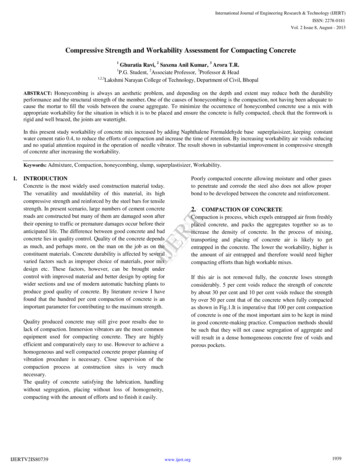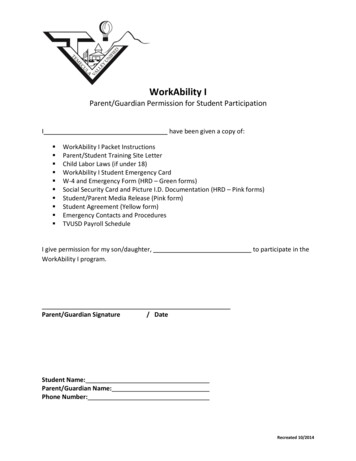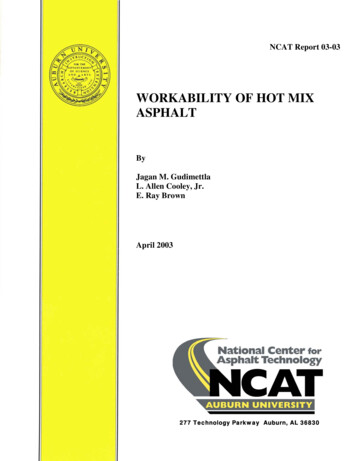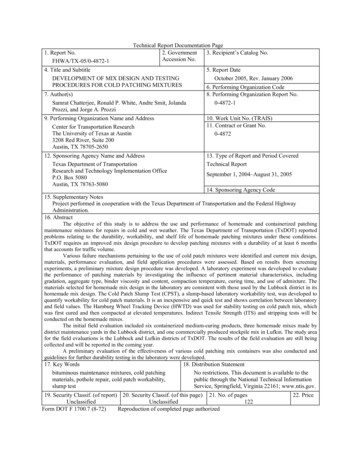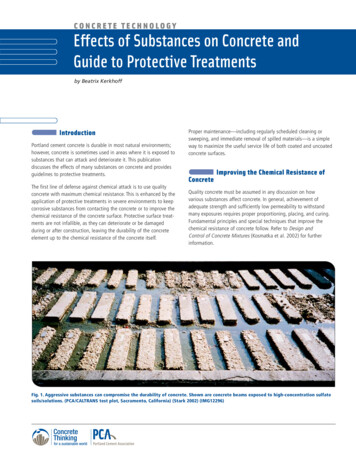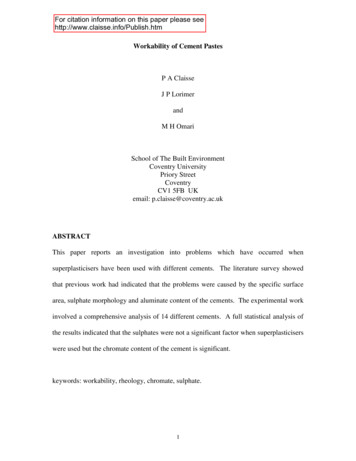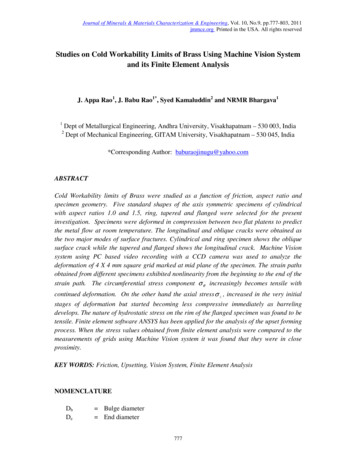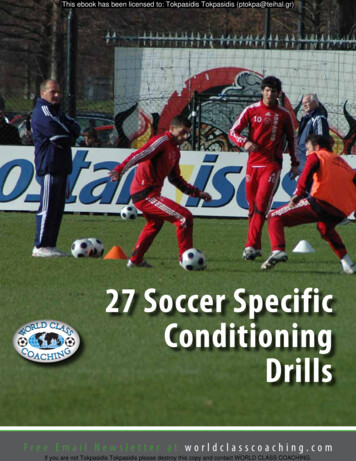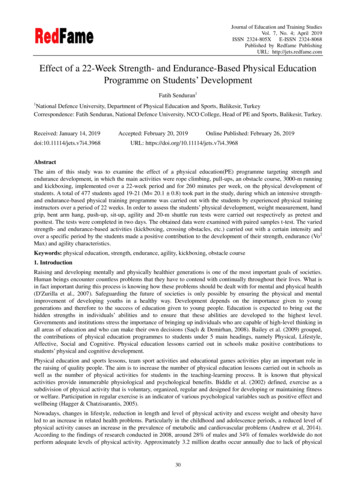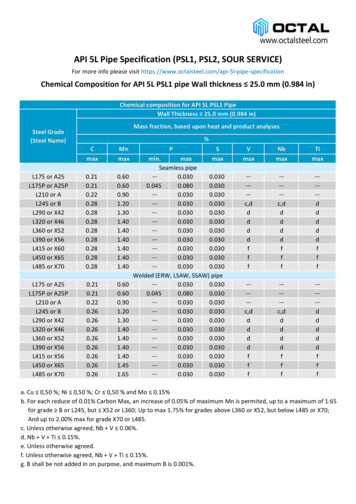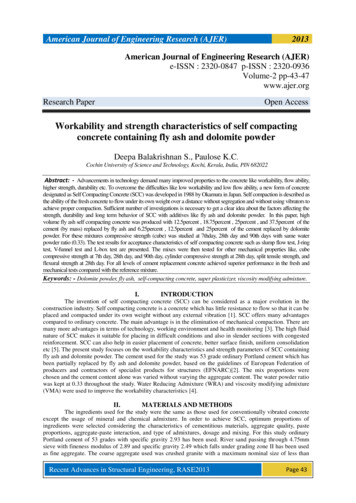
Transcription
American Journal of Engineering Research (AJER)2013American Journal of Engineering Research (AJER)e-ISSN : 2320-0847 p-ISSN : 2320-0936Volume-2 pp-43-47www.ajer.orgResearch PaperOpen AccessWorkability and strength characteristics of self compactingconcrete containing fly ash and dolomite powderDeepa Balakrishnan S., Paulose K.C.Cochin University of Science and Technology, Kochi, Kerala, India, PIN 682022Abstract: - Advancements in technology demand many improved properties to the concrete like workability, flow ability,higher strength, durability etc. To overcome the difficulties like low workability and low flow ability, a new form of concretedesignated as Self Compacting Concrete (SCC) was developed in 1988 by Okamura in Japan. Self compaction is described asthe ability of the fresh concrete to flow under its own weight over a distance without segregation and without using vibrators toachieve proper compaction. Sufficient number of investigations is necessary to get a clear idea about the factors affecting thestrength, durability and long term behavior of SCC with additives like fly ash and dolomite powder. In this paper, highvolume fly ash self compacting concrete was produced with 12.5percent , 18.75percent , 25percent , and 37.5percent of thecement (by mass) replaced by fly ash and 6.25percent , 12.5percent and 25percent of the cement replaced by dolomitepowder. For these mixtures compressive strength (cube) was studied at 7thday, 28th day and 90th days with same waterpowder ratio (0.33). The test results for acceptance characteristics of self compacting concrete such as slump flow test, J-ringtest, V-funnel test and L-box test are presented. The mixes were then tested for other mechanical properties like, cubecompressive strength at 7th day, 28th day, and 90th day, cylinder compressive strength at 28th day, split tensile strength, andflexural strength at 28th day. For all levels of cement replacement concrete achieved superior performance in the fresh andmechanical tests compared with the reference mixture.Keywords: - Dolomite powder, fly ash, self-compacting concrete, super plasticizer, viscosity modifying admixture.I.INTRODUCTIONThe invention of self compacting concrete (SCC) can be considered as a major evolution in theconstruction industry. Self compacting concrete is a concrete which has little resistance to flow so that it can beplaced and compacted under its own weight without any external vibration [1]. SCC offers many advantagescompared to ordinary concrete. The main advantage is in the elimination of mechanical compaction. There aremany more advantages in terms of technology, working environment and health monitoring [3]. The high fluidnature of SCC makes it suitable for placing in difficult conditions and also in slender sections with congestedreinforcement. SCC can also help in easier placement of concrete, better surface finish, uniform consolidationetc [5]. The present study focuses on the workability characteristics and strength parameters of SCC containingfly ash and dolomite powder. The cement used for the study was 53 grade ordinary Portland cement which hasbeen partially replaced by fly ash and dolomite powder, based on the guidelines of European Federation ofproducers and contractors of specialist products for structures (EFNARC)[2]. The mix proportions werechosen and the cement content alone was varied without varying the aggregate content. The water powder ratiowas kept at 0.33 throughout the study. Water Reducing Admixture (WRA) and viscosity modifying admixture(VMA) were used to improve the workability characteristics [4].II.MATERIALS AND METHODSThe ingredients used for the study were the same as those used for conventionally vibrated concreteexcept the usage of mineral and chemical admixture. In order to achieve SCC, optimum proportions ofingredients were selected considering the characteristics of cementitious materials, aggregate quality, pasteproportions, aggregate-paste interaction, and type of admixtures, dosage and mixing. For this study ordinaryPortland cement of 53 grades with specific gravity 2.93 has been used. River sand passing through 4.75mmsieve with fineness modulus of 2.89 and specific gravity 2.49 which falls under grading zone II has been usedas fine aggregate. The coarse aggregate used was crushed granite with a maximum nominal size of less thanRecent Advances in Structural Engineering, RASE2013Page 43
American Journal of Engineering Research (AJER)201312.5 mm, bulk density 1400 kg/m3 and specific gravity 2.85.Mineral admixtureGenerally, fly ash added to SCC for providing increased cohesion and reduced sensitivity to changesin water content. However, high levels of fly ash may produce a paste, which is so cohesive that it becomesresistant to flow. Fly ash (class F) specific gravity is 1.9407 obtained from Mettur Thermal Station was used asa partial replacement of cement up to 37.5 percent. The dolomite powder added to SCC for changing theviscosity and influencing the rheological properties of the mix. The dolomite powder which is a natural formof calcium magnesium carbonate [Ca Mg (Co3)2], with specific gravity 2.89 obtained from Rajasthan has beenused as a partial replacement of cement up to 25 percent.Chemical admixtureA high performance concrete Superplasticizer (SP) based on modified polycarboxylic ether to reducewater-powder ratio for the required workability was considered suitable for the present investigation. GleniumB233 obtained from BASF construction chemicals having relative density 1.09 and pH value 7 has been used.Glenium B233 is a ready to use admixture that can added to the concrete. The water reduction was maximumwhen Glenium B233 was added after the addition of 50 to 70 percent of the water. VMA has been added alongwith SP for control mix, which was more robust than the mix without VMA. Glenium Stream 2 having relativedensity 1.19, and pH 8 was used along with Glenium B233 to improve its performance.III.EXPERIMENTAL PROGRAMTo study the workability characteristics of SCC Slump flow test, Associated time (T500) that the SCCrequires to flow to a diameter of 500 mm, V-funnel test, L-box test and Slump flow with J-ring combinationtests were conducted . Compressive strength, Split tensile strength and Flexural strength test were carried outon the hardened SCC. The mix proportions taken for the investigation were based on the EFNARC guidelines.12.5, 18.75 and 37.5 percentage replacement of cement with fly ash and 6.25, 12.5 and 25 percentagereplacement of cement with dolomite has been used in the present investigation. The total powder content waskept 600 kg/m3. Table1 gives the details of the mix compositions.MaterialsCement (kg)Flyash (kg)Dolomite Powder (kg)Total powder content(kg)Fine aggregate (kg)Coarse aggregate (kg)Water (kg)Water powder ratioSuperplasticizer (%)VMA (%)Table 1. Mix composition per cubic meter of concrete100F075F TS AND DISCUSSIONFresh propertiesThe results of the various tests that were conducted to study the fresh properties of SCC are discussedin the subsequent sections.Slump flowThe slump flow test was conducted to assess the horizontal free flow of SCC in the absence ofobstructions. It indicates the filling ability of the concrete and also its resistance to segregation. It has beenobserved that the slump flow characteristics of the mixes are in the range of 690 and 720 mm, and T500 slumpflow time of the mixes is between 2 and 5 seconds, which satisfy the recommended values of EFNARC.Slump flow improves with the increase in fly ash content and decreases with the increase in dolomite content.The slump spread test setup is shown in Fig. 1. The workability test results with recommended values given inthe Table. 2.Recent Advances in Structural Engineering, RASE2013Page 44
American Journal of Engineering Research (AJER)2013Table 2.Workability tests results with recommended valuesRecommendedValuesMix designationMethodSlump flow(mm)T500 slump flow (Sec)V-Funnel (Sec)V-Funnel, at 5minutes(sec)L-Box ratio,H2/H1J-ring height(mm)100F0D07202675F 18.75D6.25690512Min65026Max800512810.5111415- 30.8480.82100.8250.877.50.850.83110Fig 1 Slump spread testFig 2 V-funnel time testFig 3 L-box ratio testFig 4 J-ring height testV- funnelThe filling ability of the fresh concrete was tested with V-funnel, whereby the flow time is measured.The V-funnel flow time increases from 6 to 12 seconds with increase in dolomite content indicating increase inviscosity of concrete. The results of V-funnel test confirms to the standard requirements. The values are givenin Table 2 and the test setup is shown in Fig.2.V-funnel, at 5 minutesThe segregation resistance of the fresh concrete was tested with the V-funnel, at 5 minutes. The testresults showed an increased flow time due to the reduction in flow characteristics i.e., the reduction in thepassing ability of the mix. The percentage reduction in the passing ability of the mix was observed as 17percent for addition of fly ash and 12.5 percent for dolomite powder. The results of V-funnel at 5 minutes testare given in Table 2.L-Box, H2/H1 ratioThe L-box test was conducted to assess the filling and passing ability of SCC and serious lack ofstability (segregation). No significant changes were observed for the five mixes. The blocking ratios in the Lbox test were as per the requirement of SCC mixes as laid down by EFNARC guidelines. The L-box ratio testsetup is shown in Fig. 3 and the values are given in Table 2.J-ringJ-ring test was conducted to assess the passing ability of the concrete. The accepted difference inheight between inside and outside should be between 3 and 10 mm. The results of J-ring test satisfy theEFNARC guidelines. The setup for J-ring test is shown in Fig. 4. The values are given in Table 2.Recent Advances in Structural Engineering, RASE2013Page 45
American Journal of Engineering Research (AJER)2013Hardened PropertiesThe results of the various tests that were conducted to study the hardened properties of SCC arediscussed in the subsequent sections.Compressive strengthThe compressive strength of cubes at 7th, 28th and 90th days and 28th day cylinder compressive strengthof the concrete mixes have been observed for different percent replacement of cement with fly ash anddolomite powder. From the results obtained, has been observed that the compressive strength of concreteincreased with increase in the replacement levels up to 18.75percent. Beyond that, the compressive strengthreduces. This is attributable to the amorphous nature of fly ash and filling ability of dolomite powder. Themaximum compressive strength obtained has been for a mix prepared with 25 percentage replacement ofcement with fly ash and dolomite powder (12.5 percent fly ash and 12.5 percent dolomite powder). This mixhas been taken as the optimized mix. The 28 th day compressive strength showed an increase of 8 percent whilethe 90 day compressive strength showed an increase of 9 percent with that of the control mix. This shows thestrength development may be due to the pozzolanic action of the fly ash at later ages. From the results of the28th day cylinder compressive strength of the concrete mixes, it has been observed that the cylindercompressive strength of concrete has decreased with increase in the percentage replacement of cement with flyash and dolomite powder. It has also been noticed that the compressive strength of the optimized mix showed adecrease of only about 6 percent than that of the control mix. The compressive strength results are reported inTable 3.Table 3 Compressive strength properties of concrete mixesCompressive strength (cube) N/mm2Compressive strength (Cylinder) N/mm2Mixdesignation.7 days28 days90 days28 .9625Split tensile strengthFrom the experimental investigation it has been observed that the split tensile strength showed adecreasing trend with the increasing percentage replacement of fly ash and dolomite powder. It has also beennoticed that the split tensile strength of SCC is greater than that of the control mix. For the mixes 75F12.5D12.5 and 75F 18.75D6.25 SCC the values are respectively 7 and 4 percent greater than that of control mix.12.5 to 18.75percent replacement of cement with fly ash and 6.25percent to 12.5percent replacement ofcement with dolomite powder resulted in the increase in the split tensile strength values. It is noticed that theincrease in split tensile strength has been due to the pozzolanic reactivity of fly ash and filling ability of thedolomite filler. The split tensile strength of concrete mixes are given in Table 4.Flexural strengthThe flexural strength test has been conducted on beam specimen subjected to two points loading andit has been observed that the flexural strength of mix 75F12.5D12.5 was 2.2 percent greater than that of controlconcrete. For other SCC mixes there is only a slight difference with control concrete. It is found that theflexural strength of SCC increased with an increase in replacement of cement with 12.5 percent of fly ashand 12.5 percent of dolomite powder. The higher flexural strength, has been due to the bettermicrostructure, especially the smaller total porosity and the more even pore size distribution within theinterfacial transition zone of SCC. Further the higher content of ultra fines of fly ash and dolomiteparticles which resulted in dense cement matrix also resulted in the increase in flexural strength. Theflexural strength values of concrete mixes are given in Table 4.Table 4 Tensile strength properties of concrete mixes at 28daysMix designation.Flexural strength N/mm2Split tensile strength N/mm2100F0D05.732.76Recent Advances in Structural Engineering, RASE2013Page 46
American Journal of Engineering Research (AJER)75F12.5D12.550F25D2550F37.5D12.575F18. ONSBased on the results of this investigation, it has been observed that the use of fly ash in SCC mixes reduces thepossibility of bleeding and segregation, and increases the filling and passing ability of concrete, whereas dolomitepowder imparts viscosity to the concrete and improves the segregation resistance of the concrete mix. The majorfindings of the study are: Better mechanical and physical properties of concrete can be obtained with the replacement of cement withfly ash from 12.5 percent to 18.75 percent. Further it has been observed that SCC could be prepared using dolomite powder instead of VMA. The use ofdolomite powder in self compacting concrete mixes reduces the possibility of segregation. Better fresh properties of SCC can be obtained with the replacement of cement with dolomite powder from6.25 percent to 12.5 percent. The best self compacting properties were obtained by replacing the cement with the fly ash in 37.5 percentand fine aggregate content to 55 percent of the total aggregate, using a 53 grade ordinary Portland cement and the waterpowder ratio remained as 0.33.From this experimental study it can be inferred that fly ash and dolomite powder blend well to improve the overallworkability, which is the prime characteristics of SCC. The present study promotes the use of fly ash, which isotherwise considered as waste material. Hence the fly ash–dolomite based SCC is a sustainable material for futureconstruction works. However, design methodologies are to be developed for this concrete prior to actual use in worksite.REFERENCES[1]V Bharathi,., R. J. V., Subramania, R. Regupathy, and C. Seenivasa, (2009).Workability and strengthstudy of high volume fly ash self- concrete, The Indian Concrete Journal, 83, 17-22.[2]EFNARC (2002), “Specification and Guidelines for Self Compact Concrete” EFNARC (EurepeanFederation of producers and Applications of Specialist Products for Structures).[3]H Okamura,., and M.Ouchi, (2003). Self Compacting Concrete, Journal of Advanced ConcreteTechnology, April (2003). Vol-No 1, pp: 5-15[4]R. Ravindrarajah, , F. Farrokhzadi, , and H. Lahoud. (2003). Properties of Flowing concrete and SelfCompacting Concrete with High-Performance Superplasticizer, Proceedings of the 3rd International RILEMSymposium, Reykjavik, Iceland, (RILEM Publications), 1, 1048-1058.Recent Advances in Structural Engineering, RASE2013Page 47
Abstract: - Advancements in technology demand many improved properties to the concrete like workability, flow ability, higher strength, durability etc. To overcome the difficulties like low workability and low flow ability, a new form of concrete designated as Self Compacting Concrete (SCC) was developed in 1988 by Okamura in Japan.
